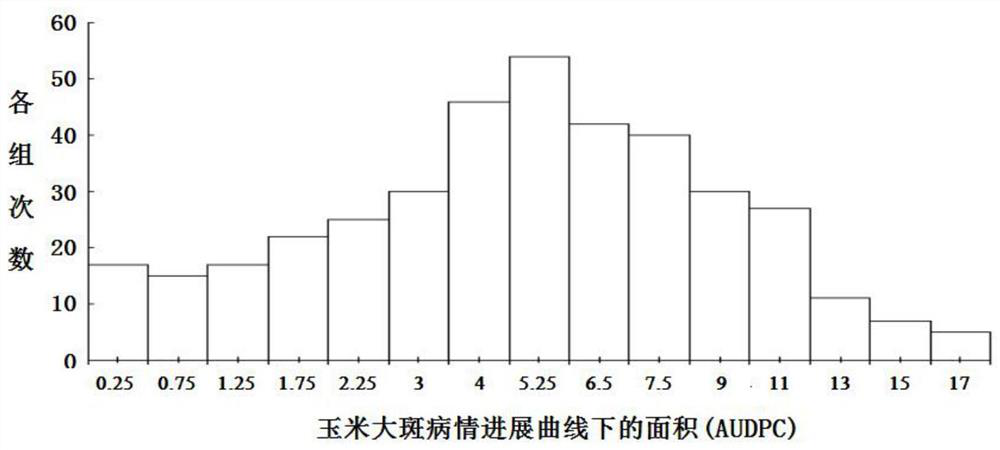ZmGNAT19 gene SNP molecular marker related to corn leaf blight resistance and application
A technology of maize leaf spot and molecular markers, which is applied in the direction of DNA/RNA fragments, recombinant DNA technology, microbial measurement/inspection, etc., can solve the problems of reduced acetylation level, reduced resistance of rice blast bacteria, etc., and achieve simplified sequencing Effect
- Summary
- Abstract
- Description
- Claims
- Application Information
AI Technical Summary
Problems solved by technology
Method used
Image
Examples
Embodiment 1
[0029] 1.1 Construction of GWAS population
[0030] The maize genome-wide association analysis population included 431 inbred lines with different genetic relationships. All the inbred lines are provided by the School of Plant Sciences of Jilin University and planted in the teaching and scientific research experiment base of the School of Plant Sciences of Jilin University (Lvyuan District, Changchun City, Jilin Province). The arrangement of the plots followed the random block design, and the blocks were repeated 3 times. The single-row plots had a row length of 3 m, a row spacing of 65 cm, and a plant-to-plant spacing of 20 cm. The field management measures were the same as those in the field.
[0031] 1.2 Collection of samples
[0032] At the 5-6 leaf stage after the emergence of corn seedlings in the plot, 3 seedlings were collected, cleaned and stored in a -20°C refrigerator.
[0033] 1.3 Disease classification of diseased leaves
[0034] The identification of disease g...
Embodiment 2
[0060] 2.1 Construction of sequencing library
[0061] (1) 200ng of genomic DNA was digested with the restriction endonuclease EcoRI, and purified and recovered by magnetic beads after complete digestion.
[0062] (2) The purified DNA after enzyme digestion was connected to Barcode adapters PI with T4 DNA Ligase, the connected product was purified and recovered by magnetic beads, and the qualified P1 primer label was recorded.
[0063] (3) All samples were mixed in equal proportions as required to form a total DNA mix, and the DNA was fragmented using covaris220. The fragment length of the fragmented DNA was about 200-500bp.
[0064] (4) After End Repair&dA-tailing, Adapter P2 is connected, and the connected product is purified and recovered by magnetic beads.
[0065] (5) Use the KAPA 2G Robust PCR Kit to amplify and enrich the adapter ligation products, use magnetic beads to purify and sort the PCR reaction products, and use 2% agarose gel electrophoresis to detect the qual...
PUM
 Login to View More
Login to View More Abstract
Description
Claims
Application Information
 Login to View More
Login to View More - R&D
- Intellectual Property
- Life Sciences
- Materials
- Tech Scout
- Unparalleled Data Quality
- Higher Quality Content
- 60% Fewer Hallucinations
Browse by: Latest US Patents, China's latest patents, Technical Efficacy Thesaurus, Application Domain, Technology Topic, Popular Technical Reports.
© 2025 PatSnap. All rights reserved.Legal|Privacy policy|Modern Slavery Act Transparency Statement|Sitemap|About US| Contact US: help@patsnap.com



